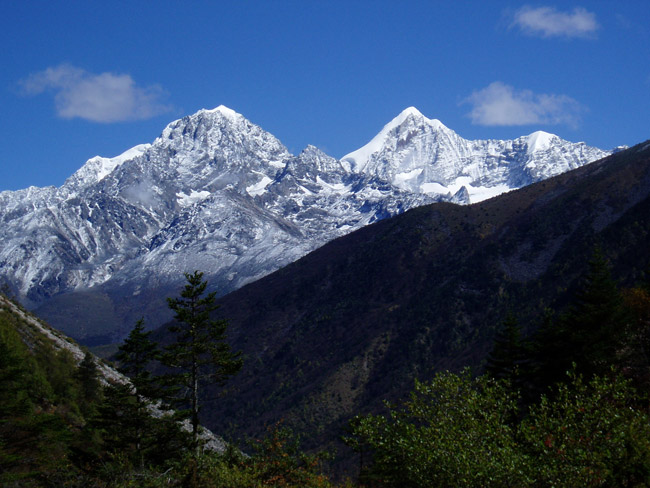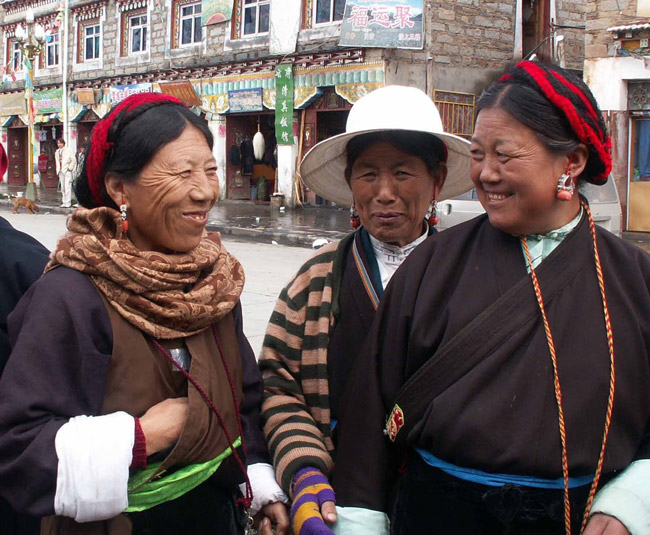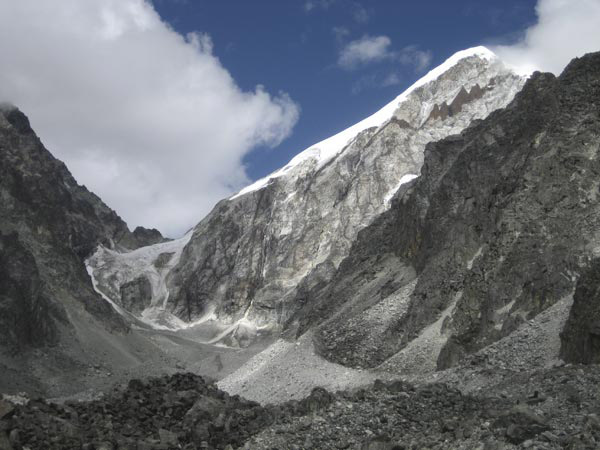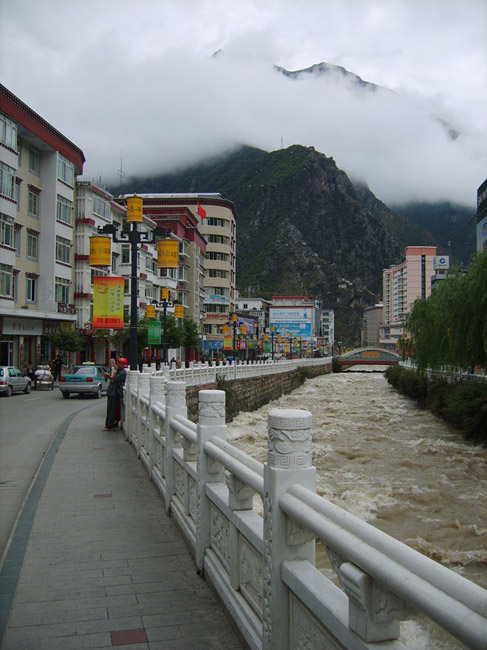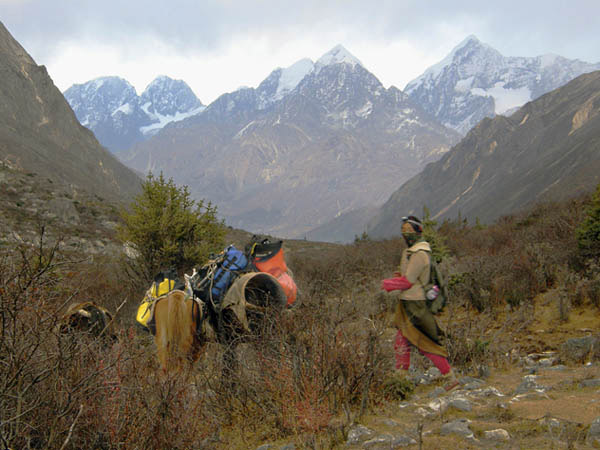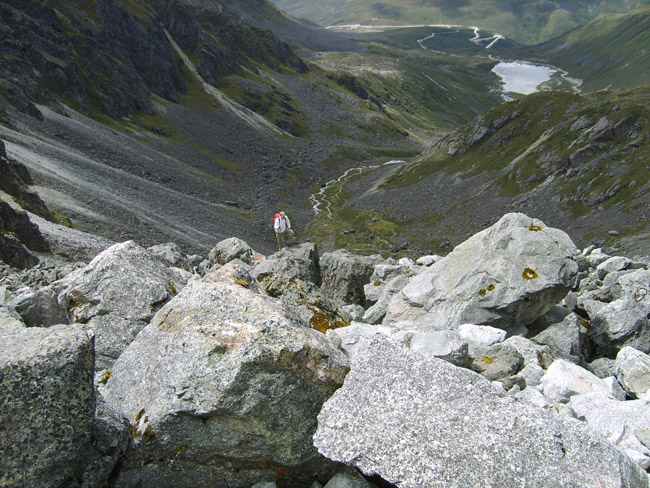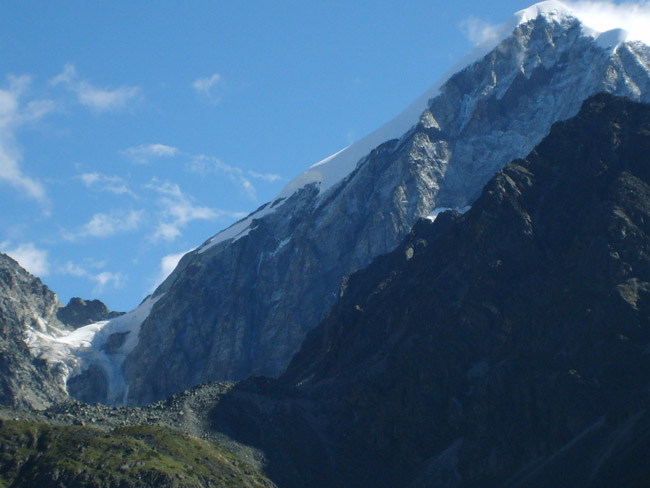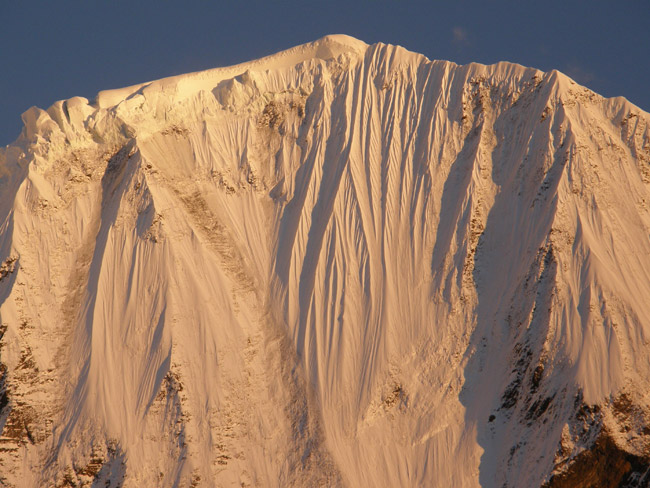Lamoshe Skills Expedition - Sichuan, China Overview Southwest China is a region with immense diversity of people, landscape, flora and fauna. The province of Sichuan exemplifies this diversity being the cultural border of Tibet and China, the domain of wild pandas and snow leopards, and containing several ranges of young, sharply etched peaks with beautiful rock faces and pristine glaciers. This region is called Kham by its Tibetan inhabitants, and was only recently opened by the Chinese government to outside visitors.
Expedition Climbing and Ascent of Lamoshe Our climbing route on Lamoshe, the north ridge is the snowy left hand skyline. Andy Bourne
The focus of the Lamoshe trip will be to help experienced expedition climbers gain safe access to wilderness alpine areas; to review an appreciation of the serious requirements placed upon the mountaineer and the entire team when climbing at altitude; and to help climbers further understand and protect the fragile alpine environment. We emphasize both concepts and skills that will allow climbers to explore this remote, high altitude alpine area safely and confidently.
This program is designed to develop technically competent rope team members, capable of safely ascending high altitude alpine routes of intermediate-to-advanced difficulty. Some participants may choose to continue on to the Reddomaine Expedition after completing this course and climb.
Lamoshe, also known as Goddess Peak, is the highest objective in this sub-range of the Daxue Shan range. This amazing 19,915-foot mountain requires moderate-to-advanced climbing ability and excellent fitness. After participants have reviewed glacier travel skills, alpine ice climbing, and high altitude mountaineering techniques, we will make the two-day summit attempt.
Lamoshe Skills Expedition - Sichuan, China Itinerary The traditional Tibetan town of Tagong is a short drive from Kangding.
We begin our expedition in Chengdu, the capitol of China's Sichuan Province. We meet in the evening over dinner to discuss our plans for the upcoming days. The next morning we depart Chengdu in private vehicles bound for Kangding, historically a trading center between China and Tibet. Kangding sits on the flanks of the Tibetan Plateau at 9000 feet elevation, perfect for our first night of acclimatization. After reaching Kangding and checking into our hotel, we have the evening to wander around town and take in the Tibetan influences. We continue our acclimatization on the third day by choosing between one of the many day hikes around Kangding which offer stunning views of the deep gorges and snowcapped peaks. Another option for our acclimatization day is to make the two hour drive to the town of Tagong, famous for Khampa Tibetan architecture and culture, as well as it's sweeping open grasslands and expert horseman.
We will review expedition packing - discerning which equipment and food is needed today, compared to that which is needed later in the expedition as well as sharing techniques for proper organization. After carefully packing our gear, we drive to the trail head at approximately 14,000 feet and begin our hike to basecamp.
The approach to advanced base camp on Lamoshe. Aidan Loehr
The second portion of the expedition involves a series of carries to get our team and equipment to advanced base camp at approximately 15,500 feet elevation. This camp is situated at the start of the route where the technical climbing begins. We stay at this camp for three nights, with the days being taken up reviewing climbing skills and techniques such as ascending fixed ropes, anchors, and efficiency. The last day we start carrying to high camp.
By the time we move to high camp at 17,000 feet, we will have completed our review of climbing techniques on snow and ice, rope team travel and use of fixed lines, expedition packing and prep, and high altitude physiology and proper acclimatization schedules. We have two full days for our summit attempt on the north ridge of Lamoshe. The route involves consistent 35 to 40 degree exposed snow and ice climbing on the increasingly exposed ridge. With our thorough acclimatization and skills review, our team will have excellent chances for reaching the summit of this remote and challenging peak.
We will spend two days descending back to base camp after our summit bid, where our horses will again meet us to aid in carrying our gear back to the car. That night we check into our hotel in Kangding and go out on the town for a celebration feast.
Prerequisites: Due to the level of difficulty and technical climbing required, prerequisites include our Alpine Ice Climbing or Alpine Mountaineering and Technical Leadership, Part 2 course, and having climbed one of the following: the North Ridge of Mt. Baker, the Kautz Glacier on Mt. Rainier, the North Face of Mt. Shuksan, or the equivalent of these options.
If you have high altitude, technical climbing experience, the Lamoshe program is a good choice. There are many trips to choose from, but this is an expedition climbing course that brings the climber into remote and challenging alpine terrain far from the "standard" destinations. Join us in China if you have a sense of adventure and want to go a little further off the beaten path.
Lamoshe Skills Expedition - Sichuan, China Dates and Details $8900 per person for 6 climbers, contact our office for lower ratio pricing.
Max Ratio - 2:1
Capacity - 6
Dates
Late September - early October
Please contact the AAI office for expedition dates.
Prerequisites
Travel Information Flights should be arranged to arrive in Chengdu, Sichuan on the first scheduled day of the program. Departing flights from Chengdu can be arranged the day after the last scheduled day.
Inclusions and Exclusions Close-up of an un-climbed peak drenched in alpenglow. Photo taken on one of AAI's recent scouting trips in Sichuan. Aidan Loehr
Inclusions:
Exclusions:
Lamoshe Skills Expedition - Sichuan, China Related Courses
Program Finder
By Location
United States - Alaska
United States - Washington
United States - California
United States - Nevada
United States - Colorado
United States - Utah
Canada - British Columbia
South America - Argentina
South America - Bolivia
South America - Ecuador
South America - Patagonia
South America - Peru
Europe - Alps and Caucasus
Asia - Nepal and Tibet
Asia - Laos, Thailand, & Vietnam
Asia - China
Asia - Japan
Africa - Tanzania
Pacific and Antarctica
By Program Type
Instructional Courses
Group Summit Climbs
Expeditions
Skills Expeditions
Private Guided Programs
Treks, Tours, & Backpacking
Corporate Outings & Services
Government & Military
By Activity
Rock Climbing
Ice Climbing
Alpine Climbing
High-Altitude Climbing
Trekking and Backpacking
Skiing & Snowboarding
Guide Training & Rescue
Avalanche Training
Departure Month
Difficulty Level
Beginner
Moderate
Intermediate
Advanced
Very Advanced
x
